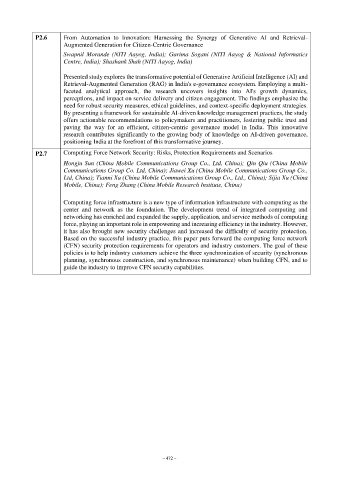Page 516 - Kaleidoscope Academic Conference Proceedings 2024
P. 516
P2.6 From Automation to Innovation: Harnessing the Synergy of Generative AI and Retrieval-
Augmented Generation for Citizen-Centric Governance
Swapnil Morande (NITI Aayog, India); Garima Sogani (NITI Aayog & National Informatics
Centre, India); Shashank Shah (NITI Aayog, India)
Presented study explores the transformative potential of Generative Artificial Intelligence (AI) and
Retrieval-Augmented Generation (RAG) in India's e-governance ecosystem. Employing a multi-
faceted analytical approach, the research uncovers insights into AI's growth dynamics,
perceptions, and impact on service delivery and citizen engagement. The findings emphasize the
need for robust security measures, ethical guidelines, and context-specific deployment strategies.
By presenting a framework for sustainable AI-driven knowledge management practices, the study
offers actionable recommendations to policymakers and practitioners, fostering public trust and
paving the way for an efficient, citizen-centric governance model in India. This innovative
research contributes significantly to the growing body of knowledge on AI-driven governance,
positioning India at the forefront of this transformative journey.
P2.7 Computing Force Network Security: Risks, Protection Requirements and Scenarios
Hongju Sun (China Mobile Communications Group Co., Ltd, China); Qin Qiu (China Mobile
Communications Group Co. Ltd, China); Jiawei Xu (China Mobile Communications Group Co.,
Ltd, China); Tianni Xu (China Mobile Communications Group Co., Ltd., China); Sijia Xu (China
Mobile, China); Feng Zhang (China Mobile Research Institute, China)
Computing force infrastructure is a new type of information infrastructure with computing as the
center and network as the foundation. The development trend of integrated computing and
networking has enriched and expanded the supply, application, and service methods of computing
force, playing an important role in empowering and increasing efficiency in the industry. However,
it has also brought new security challenges and increased the difficulty of security protection.
Based on the successful industry practice, this paper puts forward the computing force network
(CFN) security protection requirements for operators and industry customers. The goal of these
policies is to help industry customers achieve the three synchronization of security (synchronous
planning, synchronous construction, and synchronous maintenance) when building CFN, and to
guide the industry to improve CFN security capabilities.
– 472 –

